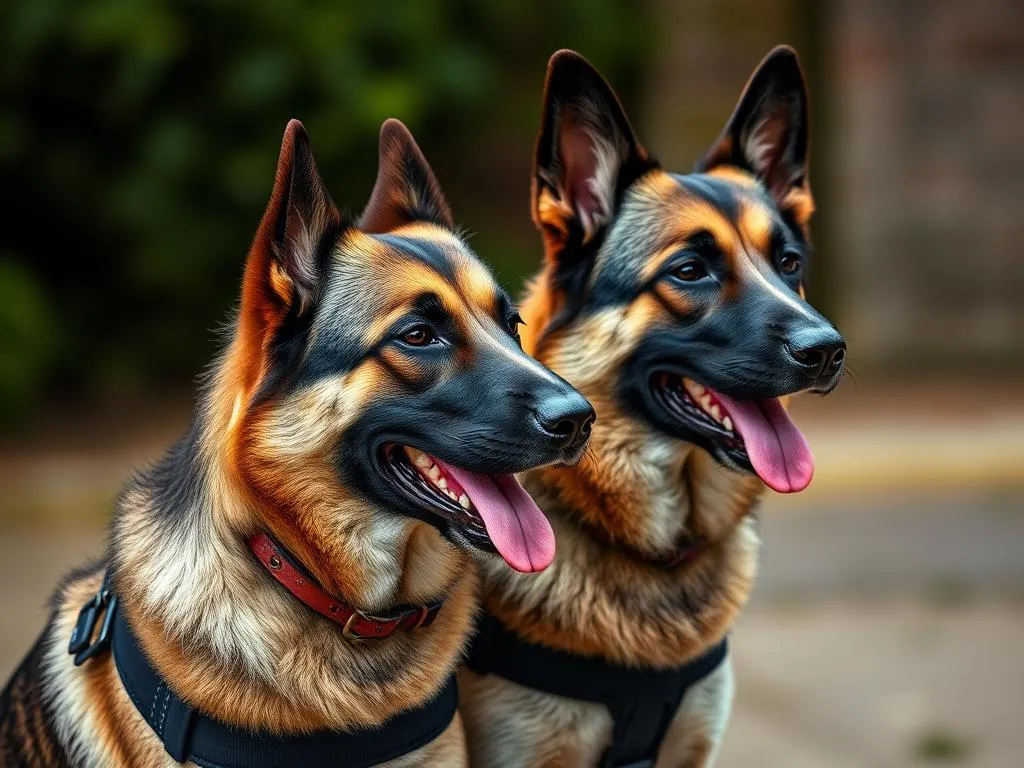
Introduction
Dogs have long held a significant role in law enforcement, serving alongside officers to enhance safety and security. The selection of the right breed for police work is crucial, as not all dogs possess the necessary traits to excel in such demanding environments. In this article, we will explore various police dog breeds, their characteristics, training requirements, and the vital roles they play in law enforcement.
Understanding Police Dog Breeds
What Are Police Dogs?
Police dogs, also known as K9s, are specially trained canines utilized by law enforcement agencies to assist in various tasks. These dogs are trained to perform duties such as search and rescue, drug and explosive detection, and suspect apprehension. Historically, the role of dogs in law enforcement dates back centuries. The first documented use of dogs in policing occurred in the 19th century, with breeds like the Bloodhound being used for tracking criminals.
The Importance of Breed Selection
Choosing the right breed for police work involves several considerations. Key factors include physical traits, temperament, and trainability. Police dog breeds must possess specific characteristics such as strength, agility, intelligence, and a strong prey drive. These traits ensure that the dogs can perform their duties effectively and respond well to training.
Popular Police Dog Breeds
German Shepherd
The German Shepherd is one of the most recognized police dog breeds. Known for their intelligence and versatility, German Shepherds are often used in various law enforcement roles. They are highly trainable, making them suitable for tasks like search and rescue, narcotics detection, and apprehension.
Historically, German Shepherds have played notable roles in police work. One of the most famous was Rin Tin Tin, who served as a K9 in the 1920s and became a Hollywood star. Their loyalty and dedication have made them a favorite among police departments worldwide.
Belgian Malinois
While similar to the German Shepherd, the Belgian Malinois is often lighter and more agile. This breed has gained popularity in recent years, particularly for specialized tasks such as narcotics detection and protection work. Their high energy and strong work ethic make them exceptional at performing complex tasks.
However, Belgian Malinois dogs also have their weaknesses. They require extensive training and socialization to ensure proper behavior in various situations. Despite these challenges, their strong drive and intelligence make them a top choice for many law enforcement agencies.
Labrador Retriever
The Labrador Retriever is another popular breed in police work, particularly for detection roles. Known for their friendly disposition and eagerness to please, Labs excel in narcotics and explosives detection. Their adaptability allows them to work in various environments, making them effective partners for law enforcement.
Training a Labrador for police work involves teaching them to focus on their tasks while maintaining their friendly demeanor. Their natural ability to connect with people also helps foster positive community relations, which is essential for police departments.
Rottweiler
The Rottweiler is often misunderstood, with many people seeing them as aggressive guard dogs. However, Rottweilers have also served effectively in law enforcement roles, particularly in protection and apprehension. Their physical strength and loyalty make them excellent partners in high-stress situations.
Training Rottweilers for police work requires a firm yet positive approach. Their natural instinct to protect their handlers can be harnessed effectively, but it also necessitates careful training to ensure they can differentiate between real threats and non-threatening situations.
Doberman Pinscher
The Doberman Pinscher has a long history of service in law enforcement. Known for their intelligence and loyalty, Dobies are often utilized in protection roles. Their natural agility and speed make them effective in apprehension tasks.
Historically, Dobermans have been used by military and police forces since the early 20th century. Their distinct appearance and commanding presence make them a powerful asset in law enforcement, especially in situations that require intimidation or protection.
Other Notable Breeds
In addition to the aforementioned breeds, several others contribute significantly to law enforcement efforts. Bloodhounds are renowned for their tracking abilities, making them invaluable in search and rescue operations. Springer Spaniels are often used for drug detection due to their keen sense of smell. Boxers can also serve in various capacities, including as protection dogs and trackers.
Each of these breeds brings unique strengths and characteristics to law enforcement, enhancing the overall capabilities of police departments.
Training Police Dogs
Basic Training Principles
Training police dogs involves a comprehensive approach that begins with basic obedience training. Foundational training methods focus on commands such as sit, stay, and come. Socialization is also crucial, helping dogs become comfortable in diverse environments and with various people.
Effective training programs rely on positive reinforcement methods, rewarding dogs for good behavior to encourage learning and obedience. This foundational training sets the stage for more specialized skills later on.
Specialized Training Programs
Once basic training is established, police dogs undergo specialized training programs tailored to their roles. These programs can include narcotics detection, search and rescue, tracking, and protection. Each area of specialization requires different techniques and training regimens.
The role of a canine handler is vital during this training process. Handlers work closely with their dogs, building trust and understanding that enhance their performance in the field. Handlers must also be trained to recognize the signs and behaviors of their dogs, ensuring effective communication during operations.
Ongoing Training and Maintenance
Training does not end once a police dog has completed its initial program. Ongoing training and maintenance are crucial for sustaining the skills and abilities of police dogs. Regular practice sessions help reinforce learned behaviors and introduce new challenges to keep the dogs engaged.
Handlers play an essential role in this ongoing training process. They must remain proactive in maintaining their dogs’ skills and addressing any behavioral issues that may arise. This continuous training ensures that police dogs remain effective partners in law enforcement.
The Role of Police Dogs in Law Enforcement
Search and Rescue Operations
Police dogs are invaluable during search and rescue operations. Their keen sense of smell and ability to navigate various terrains enable them to locate missing persons quickly. Techniques such as scent tracking can significantly increase the chances of a successful rescue.
Numerous success stories highlight the effectiveness of police dogs in these operations. For example, during natural disasters, K9 units have been instrumental in locating survivors trapped under debris or lost in dense forests.
Drug and Explosive Detection
One of the most critical functions of police dogs is their ability to detect drugs and explosives. Through specialized training, dogs learn to identify specific scents associated with narcotics and explosive materials. This capability is crucial for law enforcement agencies in combating drug trafficking and ensuring public safety.
The methods used by police dogs in detection involve a combination of scent training and reward-based motivation. When a dog successfully identifies the target scent, they are rewarded with praise or treats, reinforcing the behavior.
Apprehension and Protection
Police dogs also play a significant role in apprehending suspects. Their natural instincts, combined with specialized training, allow them to assist officers in safely apprehending individuals who pose a threat. Techniques employed during apprehension focus on controlling aggression while ensuring the safety of both the dog and the suspect.
Balancing aggression and control is crucial in these situations. Handlers must ensure that their dogs are trained to respond appropriately, following commands without unnecessary force.
Community Relations
The presence of police dogs can significantly enhance community relations. These dogs often participate in community events, fostering trust and goodwill between law enforcement and the public. Interactions with K9s can create positive experiences for community members, helping to break down barriers that may exist between citizens and law enforcement.
Programs involving police dogs in schools, community fairs, and public demonstrations help educate the public about their roles and the importance of their training. These initiatives contribute to a more positive perception of law enforcement as a whole.
Challenges and Considerations
Health and Well-being of Police Dogs
The health and well-being of police dogs are critical considerations for law enforcement agencies. Common health issues can arise due to the physical demands placed on these dogs, including joint problems and obesity. Preventive care, including regular veterinary check-ups, is essential to ensure the dogs remain healthy and fit for duty.
Mental stimulation and exercise are also vital for police dogs. Engaging activities, such as agility training or interactive play, help keep their minds sharp and reduce stress, ultimately enhancing their performance in the field.
Ethical Considerations
The treatment and retirement of police dogs raise ethical considerations for law enforcement agencies. Once a police dog retires, it is essential to ensure they receive proper care and a loving home. Many agencies have policies in place to facilitate the adoption of retired K9s by their handlers or other suitable families.
Law enforcement agencies bear legal and moral responsibilities regarding their K9s. Ensuring that these dogs are treated with respect and dignity throughout their lives reflects the values of the agency and the community they serve.
Public Perception
Public opinion can significantly influence the use of police dogs in law enforcement. While many people appreciate the contributions of K9s, others may harbor misconceptions about their roles and behavior. Addressing these misconceptions is crucial for fostering a positive relationship between police departments and the communities they serve.
Educational initiatives that provide information about the training and purpose of police dogs can help dispel myths and promote understanding. Open communication between law enforcement and the public fosters trust and enhances the effectiveness of police work.
Conclusion
Understanding the intricacies of police dog breeds is essential to appreciate their vital contributions to law enforcement. From search and rescue operations to drug detection and community engagement, these dogs play multi-faceted roles that enhance public safety. The future of police work will undoubtedly continue to benefit from the unique abilities and unwavering loyalty of these remarkable canine partners. As we move forward, supporting local police dog programs and understanding their roles will be crucial in fostering strong community-police relationships.









